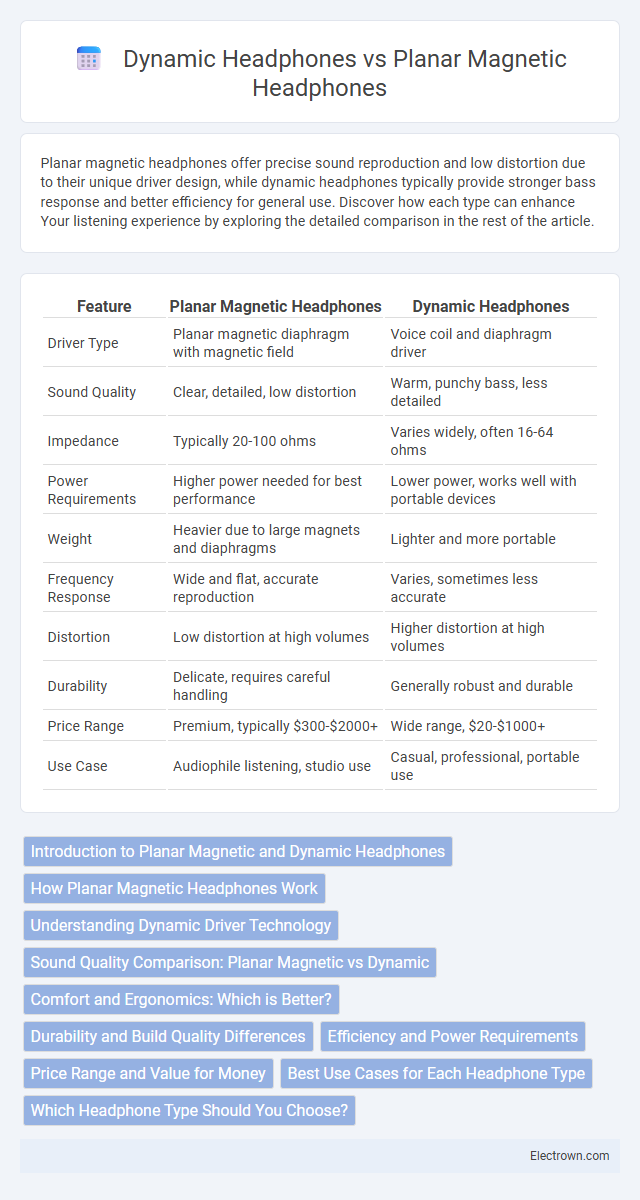Planar magnetic headphones offer precise sound reproduction and low distortion due to their unique driver design, while dynamic headphones typically provide stronger bass response and better efficiency for general use. Discover how each type can enhance Your listening experience by exploring the detailed comparison in the rest of the article.
Table of Comparison
| Feature | Planar Magnetic Headphones | Dynamic Headphones |
|---|---|---|
| Driver Type | Planar magnetic diaphragm with magnetic field | Voice coil and diaphragm driver |
| Sound Quality | Clear, detailed, low distortion | Warm, punchy bass, less detailed |
| Impedance | Typically 20-100 ohms | Varies widely, often 16-64 ohms |
| Power Requirements | Higher power needed for best performance | Lower power, works well with portable devices |
| Weight | Heavier due to large magnets and diaphragms | Lighter and more portable |
| Frequency Response | Wide and flat, accurate reproduction | Varies, sometimes less accurate |
| Distortion | Low distortion at high volumes | Higher distortion at high volumes |
| Durability | Delicate, requires careful handling | Generally robust and durable |
| Price Range | Premium, typically $300-$2000+ | Wide range, $20-$1000+ |
| Use Case | Audiophile listening, studio use | Casual, professional, portable use |
Introduction to Planar Magnetic and Dynamic Headphones
Planar magnetic headphones use a thin diaphragm suspended between two magnetic arrays, producing sound through an even magnetic field that ensures low distortion and precise audio reproduction. Dynamic headphones operate with a voice coil attached to a diaphragm, moving within a magnetic field to generate sound, offering efficient bass response and higher sensitivity. Both technologies cater to different listening preferences, with planar magnetics favored for accuracy and dynamic drivers for power and affordability.
How Planar Magnetic Headphones Work
Planar magnetic headphones utilize a thin, flat diaphragm embedded with conductive wires suspended between powerful magnets, creating an even magnetic field that drives the diaphragm precisely. This design reduces distortion and delivers a more accurate, detailed audio reproduction compared to dynamic headphones, which use a coil attached to a cone. Your listening experience benefits from enhanced clarity and a wider soundstage due to the rapid response and low distortion inherent in planar magnetic technology.
Understanding Dynamic Driver Technology
Dynamic driver headphones utilize a voice coil attached to a diaphragm that moves within a magnetic field, producing sound through electromagnetic induction. The technology enables efficient sound reproduction with strong bass response and wide frequency range, ideal for varied audio genres. Compared to planar magnetic drivers, dynamic drivers often deliver higher sensitivity and lower power consumption, making them popular for portable and consumer headphones.
Sound Quality Comparison: Planar Magnetic vs Dynamic
Planar magnetic headphones deliver precise, detailed sound with low distortion due to their uniform driver movement and large diaphragm surface, resulting in a broader soundstage and clearer mids and highs. Dynamic headphones often provide a punchier bass response and higher efficiency but may exhibit slight distortion at high volumes, affecting sound clarity and detail. Your choice depends on whether you prioritize the transparent, balanced sound of planar magnetic drivers or the warm, impactful audio typical of dynamic drivers.
Comfort and Ergonomics: Which is Better?
Planar magnetic headphones typically offer more even pressure distribution across the ear, resulting in enhanced comfort during extended listening sessions. Dynamic headphones tend to be lighter and more compact, which can benefit portability and reduce fatigue for some users. Your comfort depends on factors like headband padding, ear cup size, and clamping force, so trying both types can help determine the best ergonomic fit for your needs.
Durability and Build Quality Differences
Planar magnetic headphones typically feature robust materials like aluminum frames and reinforced diaphragms, enhancing durability compared to dynamic headphones that often use plastic components. The build quality of planar magnetic models prioritizes precision and longevity, making them less prone to wear and tear during extended use. Your choice between the two should consider planar magnetic headphones for greater structural resilience and reliable long-term performance.
Efficiency and Power Requirements
Planar magnetic headphones generally exhibit lower efficiency than dynamic drivers, requiring more power to achieve similar volume levels. Dynamic headphones can reach higher sound pressure levels with less amplifier power, making them suitable for portable devices with limited output. Your choice of headphone depends on whether your audio source can deliver the necessary power for optimal planar magnetic performance.
Price Range and Value for Money
Planar magnetic headphones typically come with a higher price range due to advanced technology and superior sound clarity, often starting around $300 and reaching over $2,000. Dynamic headphones offer more affordable options, usually ranging from $50 to $500, making them accessible for budget-conscious listeners without sacrificing decent audio quality. Your choice between the two depends on whether you prioritize premium sound performance or cost-effective value for everyday use.
Best Use Cases for Each Headphone Type
Planar magnetic headphones excel in delivering precise, detailed sound with low distortion, making them ideal for critical listening, mixing, and mastering in professional audio environments. Dynamic headphones offer strong bass response and greater efficiency, making them well-suited for casual listening, gaming, and portable use where battery life and durability are priorities. Audiophiles and studio professionals often prefer planar magnetic models for accuracy, while dynamic headphones cater to everyday users seeking versatility and convenience.
Which Headphone Type Should You Choose?
Planar magnetic headphones offer precise sound reproduction with low distortion, ideal for audiophiles seeking detailed audio clarity and extended frequency response. Dynamic headphones provide strong bass impact and efficient power usage, making them suitable for casual listeners and everyday use with durable designs. Choose planar magnetic for studio-grade listening and dynamic for versatile, budget-friendly options.
planar magnetic vs dynamic headphones Infographic

 electrown.com
electrown.com